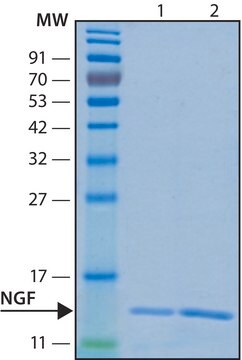N8133
Nerve Growth Factor from Vipera lebetina venom
NGF, lyophilized powder, suitable for cell culture
Iniciar sesiónpara Ver la Fijación de precios por contrato y de la organización
About This Item
Productos recomendados
origen biológico
Vipera Lebetina
Nivel de calidad
formulario
lyophilized powder
potencia
0.2-20 μg/mL ED50/EC50
calidad
endotoxin tested
mol peso
protein 32.5 kDa
envase
pkg of 0.1 mg
técnicas
cell culture | mammalian: suitable
impurezas
<10 EU/vial
color
white to off-white
Nº de acceso UniProt
temp. de almacenamiento
−20°C
Forma física
Lyophilized from a 0.2 μm filtered solution in sodium acetate buffer.
Nota de preparación
Isolated from the snake venom of V. lebetina.
Nota de análisis
The biological activity of Nerve Growth Factor (NGF) from Vipera lebetina venom is measured in a cell proliferation assay using PC-12 cells.
Código de clase de almacenamiento
11 - Combustible Solids
Clase de riesgo para el agua (WGK)
WGK 3
Punto de inflamabilidad (°F)
Not applicable
Punto de inflamabilidad (°C)
Not applicable
Equipo de protección personal
Eyeshields, Gloves, type N95 (US)
Certificados de análisis (COA)
Busque Certificados de análisis (COA) introduciendo el número de lote del producto. Los números de lote se encuentran en la etiqueta del producto después de las palabras «Lot» o «Batch»
¿Ya tiene este producto?
Encuentre la documentación para los productos que ha comprado recientemente en la Biblioteca de documentos.
Jeremy E Purvis et al.
Cell, 152(5), 945-956 (2013-03-05)
A growing number of studies are revealing that cells can send and receive information by controlling the temporal behavior (dynamics) of their signaling molecules. In this Review, we discuss what is known about the dynamics of various signaling networks and
Tao Yu et al.
The Journal of neuroscience : the official journal of the Society for Neuroscience, 34(17), 6098-6106 (2014-04-25)
Trk neurotrophin receptor ubiquitination in response to ligand activation regulates signaling, trafficking, and degradation of the receptors. However, the in vivo consequences of Trk ubiquitination remain to be addressed. We have developed a mouse model with a mutation in the
Federica De Angelis et al.
Journal of cellular physiology, 229(6), 783-790 (2013-10-30)
The peripheral application of the M2 cholinergic agonist arecaidine on sensory nerve endings shows anti-nociceptive properties. In this work, we analyze in vitro, the mechanisms downstream M2 receptor activation causing the analgesic effects, and in vivo the effects produced by
Yu-Jung Chang et al.
Biochimica et biophysica acta, 1830(8), 4130-4136 (2013-04-16)
Neurotrophins are important regulators for neural development and regeneration. Nerve growth factor (NGF) therapy has been tested in various models of neural injury and degeneration. However, whether NGF can reach target tissues and maintain effective concentration for a certain period
M Florencia Iulita et al.
Trends in pharmacological sciences, 35(7), 338-348 (2014-06-26)
Alzheimer's disease (AD) is a devastating neurodegenerative condition and the most common type of amnestic dementia in the elderly. Individuals with Down syndrome (DS) are at increased risk of developing AD in adulthood as a result of chromosome 21 trisomy
Nuestro equipo de científicos tiene experiencia en todas las áreas de investigación: Ciencias de la vida, Ciencia de los materiales, Síntesis química, Cromatografía, Analítica y muchas otras.
Póngase en contacto con el Servicio técnico





